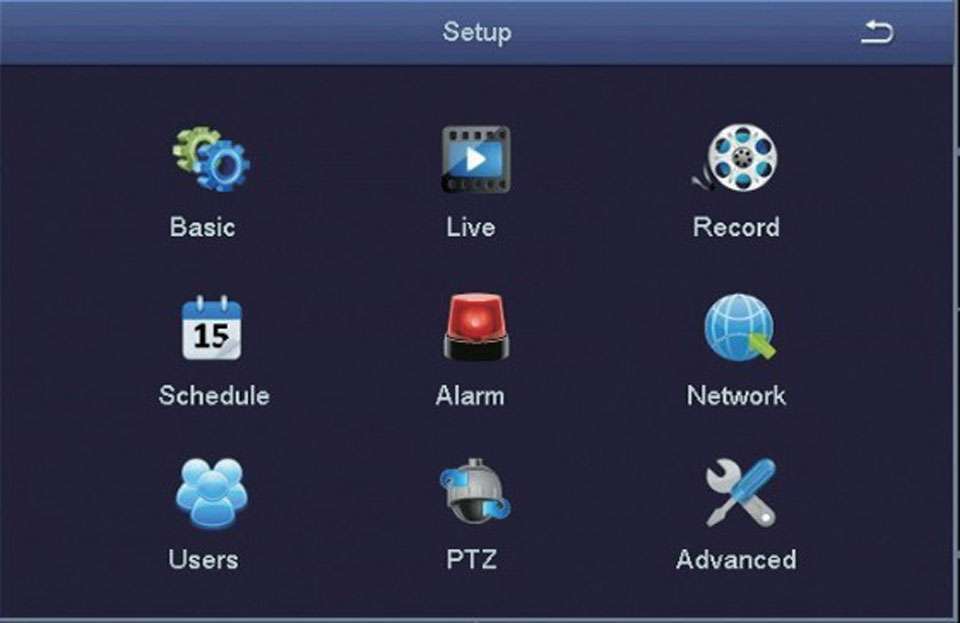How to set up Zosi XVR System, The DVR series is a HD surveillance product that designed for security field. It uses an embedded LINUX operating system to ensure stable system performance. It adopts the standard H.265 video compression algorithm and a unique spatial-temporal filtering algorithm to achieve high-quality, low-bitrate synchronous audio and video and 24/7 video recording.
Production Introduction
The DVR series is a HD surveillance product that designed for security field. It uses an embedded LINUX operating system to ensure stable system performance. It adopts the standard H.265 video compression algorithm and a unique spatial-temporal filtering algorithm to achieve high-quality, low-bitrate synchronous audio and video and 24/7 video recording. With TCP/IP network technologies, it
has powerful network data transmission and remote control capabilities.
The DVR can be used locally or online applied as a part of a safety surveillance network. With professional network video surveillance software, it fully demonstrates its strong networking and telecommunication capabilities.
This DVR can be applied to security measures in various fields and departments such as banking, telecommunications, electric power system, judiciary system, transportation, smart communities, factories, warehouses and water facilities.
Unboxing and Initial Setup
When you receive this product, please confirm that it matches the model you ordered and carefully inspect the device for any obvious damage. After opening the casing, check whether the data cable, power cable, and other connections inside the device are firmly connected to the main board.
Please protect the labels attached to the bottom or back panel, which is very important to our after-sales service work. When contacting our company for after-sales service, you will need to provide the model and serial number on the order label.
 Gallery
Gallery
Power Indicator
Network Indicator
⑨ ⑩ ⑪
Hard drive
LAN
HD Digital Video Recorder
Video Input
⑧
Audio Output
![]()
![]()

⑫ USB2.0
VGA Ethernet Port
Audio Input
HDMI
USB2.0 Power Port
NOTE: The picture shown is for reference only. Actual appearance is subject to the model you purchased.
How to set up Zosi XVR System
Read More : How to Connect Zosi wifi cameras to nvr
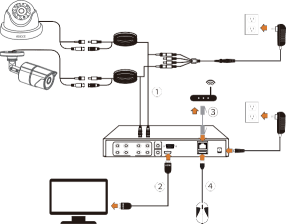
Suggestion: Please test the product before installation to ensure it is functioning properly.
Ⓒ Connect the camera to the DVR via a BNC cable.
Ⓒ Connect the DVR to the monitor via an HDMI or VGA cable.
Ⓒ Connect the DVR to the router via a network cable.
Ⓐ Connect the mouse to the USB port of the DVR.
Ⓒ Power on the DVR by connecting it to a power source.
⑥ The monitor will display the real-time monitoring image from the camera.
Via Smartphone
![]() Search “ZOSI” in App Store, or use a browser to scan the QR code below to download and install the App, and follow the on-screen instructions to complete the initial setup.
Search “ZOSI” in App Store, or use a browser to scan the QR code below to download and install the App, and follow the on-screen instructions to complete the initial setup.
![]()


![]() App video operation link
App video operation link
Via PC
Download: https://www.zositech.com/app/
Basic Operation
After connecting the power supply, the power indicator light will turn on, and the device will start up. At this time, you will hear a “beep” from the buzzer. By default, the system is in multi-screen mode.
Mouse Use:
Left-click:
Double-click a single-channel to make it full screen, and double-click again to return to the multi-channel display.
Click once to open a menu option. Right-click:
Click once to exit the current menu or return to the previous menu option.
Left-click Right-click
After the device is powered on normally, you need to log in to the system before operating it. The system will provide corresponding functions according to the permissions of the logged-in user.
The default for the device is “admin” and the default password is blank. You can log in to the system directly the first time after powering on.
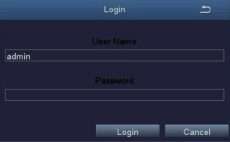
After entering the preview page, double-click the left mouse button to switch between single or multiple display. On each preview screen, the date, time, and channel name can be displayed, and each screen display the recording and alarm status of the monitoring channel.
|
Green |
Manual Recording or Trigger Recording |
Red |
Alarm Recording |
|
Yellow |
Motion Detection Recording |
Blue |
Schedule Recording |
|
|
Network Disconnection |
|
|
![]()
![]()
![]()
![]() Motion Detection Triggered Motion+PIR Detection Triggered
Motion Detection Triggered Motion+PIR Detection Triggered
Human-Figure Detection Triggered
![]() PIR Detection Triggered Vehicle Detection Triggered
PIR Detection Triggered Vehicle Detection Triggered
In preview mode, click the right mouse button to bring up the quick menu, and click the right mouse button again to exit the quick menu.
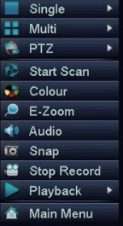 Start Scan
Start ScanStart Scan refers to the system automatically displaying each live video in sequence according to the order of the devices in channel lists. The jump button is available only when the user selects the channel in [Main Menu]>[Setup]>[Live], and when not all channels can be displayed completely in the current preview mode.
Adjust image settings for all channels: Brightness, Contrast, Saturation and Hue.
Zoomed in digitally up to 4X or 8X of single channel.
Set the audio settings for each channel to enable, disable, or mute audio, and adjust the volume. When [Auto] is selected, the audio will be enabled automatically when switching to the full-screen display.
Control the RS485 devices of all channels. Set the address, baud rate, protocol, preset points, patrol routes, tracks, etc. of the RS485 device in [Main Menu] > [Setup]
> [PTZ ]
Note: Due to differences in product design, some devices may not support RS485 interface.

Right-click and select Playback to choose between Video Playback/Quick Playback, Video Playback: Search for the video you want by time or event, then click Play.
Quick Playback: Quickly playback the first 30 minutes of video.
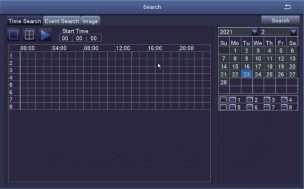



Play/Pause
Fast Rewind Forward
Multi-screen display
Previous Record Next Record
Previous Video: Go to the previous recorded event.
Next Video: Go to the next recorded event.
Fast Forward: The video can be played at different speeds, from 1/4x to 16x. Rewind: The video can be played at 1x, 8x, 16x, and 32x speed for rewind viewing. Display Mode: Both single-screen and multi-screen display modes are available. You can choose the number of screens you want to play simultaneously. Channels without recordings will display a black screen during playback.
Main Menu
|
Main menu |
Submenu |
Function |
|
Setup |
Basic configuration |
Set the system time, date format, time format, language, the device number, video format, standby time, daylight saving time |
|
Live configuration |
Set the channel name, output mode, block area of each channel, etc |
|
|
Record |
Set video recording , the video stream, superposition of channel characters, video circulation, snapshot, etc |
|
|
Schedule |
Set schedule recording, motion alarm recording, time period of sensor alarm recording |
|
|
Alarm |
Set sensor alarm, motion detection,Vehicle detection,human detection, PIR detection, video loss and other alarms for each channel |
|
|
Network configuration |
Set basic network parameters, network sub-stream, email, WIFI and Dynamic Domain Name Service |
|
|
User management |
Modify users, change passwords, add users and delete users |
|
|
PTZ |
Set the PTZ address, baud rate, protocol, preset points, cruise routes , track, etc. |
|
|
Advanced configuration |
Restore the factory settings, import and export the device parameters |
|
Search |
Time search |
Search specified period of time recording , playback the video of this period |
|
Event search |
Search motion detection, sensor alarm and all videos, play back the video of this period |
|
|
Image |
Delete, lock and save the video files of specified time period |
|
|
Backup |
|
Click the corresponding date and time, select the channel that you want to back up |
|
Information |
System Info |
Display the device name, serial number, version, and release date |
|
Event Info |
Inquiry and export of motion detection, video loss, sensor alarm and other events |
|
|
System Log |
Search equipment operation log according to time, it can also be exported |
|
|
Network Status |
Information of network settings and dynamic DNS settings |
|
|
Online Users |
Display the network users currently accessing the device |
|
|
Disk Management |
|
Total disk space, remaining space, read/write status, and format the disk |
|
Upgrade Maintenance |
|
Upgraded with an external device ( e.g.: USB) |
|
User Logoff |
|
Log out and exit the system |
|
System Shutdown |
|
|
Set functional parameters of the device, including: Basic Configuration, Live Configuration, Recording Configuration, Recording Schedule, Alarm Configuration, Network Configuration, User Management, PTZ Configuration, Advanced Configuration.
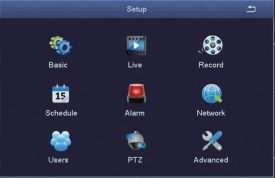
Basic configuration contains 3 sub-menus: System, Date & Time, and DST
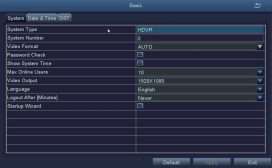
[System Type]: The name of the system displayed on the client
[Model Number]: Used for controlling multiple DVRs with one remote control [Video Format]: Supports PAL and NTSC video format.
[Password Check]: Checking this option means that users must enter a username
and password in the system settings and have the corresponding permissions to perform certain operations.
[Show System Time]: Choose whether to display the time on the scene.
[Max Online Users]: Set the number of network users who can access the device. [Video Output]: Users can select output resolutions 1024×768, 1280×1024, 1920×1080, etc.
[Logout After (Minutes)]: The system automatically logs out after a set time of inactivity. [Startup Wizard]: Whether to display the wizard on startup.
Set the date format, time format, time zone, and manually adjust the system time.
NOTE: The system default time zone of the system is GMT. You can select
[Time Synchronization] to correct the time. The network time server can also be set.
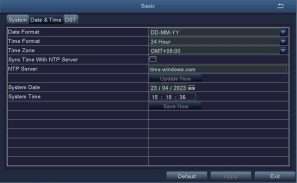
Set the start and end times of daylight saving time through the week or date.
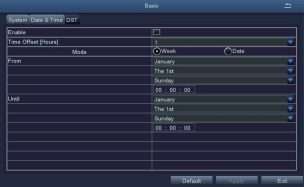
Live configuration contains 3 sub-menus: Live, Main Monitor, and Video Video Masking.


[Camera Name] Click on the camera name, and a software keyboard will pop up. Users can modify the camera name as needed.
Click on the Shift key to switch input method.
[Colour] Users can adjust the brightness, hue, saturation, and contrast of the channel.
[Interval] The time interval for switching from one channel to another in sequence during channel rotation.
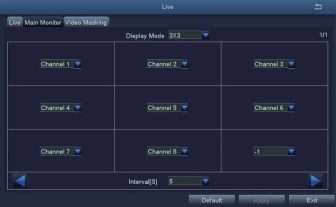
Users can mask certain areas in the scene, max 4 areas.
[Setting] Enter the live view, hold down the left mouse button, drag the mouse to set the blocked area, click [Apply] to save the setting.
Double-click the area that needs to be deleted, and the area will turn black. Right-click
to exit, and then click[Apply] to delete the blocked area.
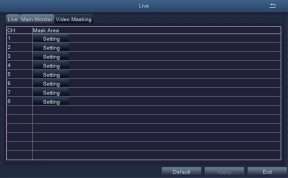
Recording configuration contains 5 sub-menus: Enable, Record Bitrate, Stamp, Recycle Record, and Snap
Enable/disable recording and audio functions for a specific channel, or set all channels to default enable.
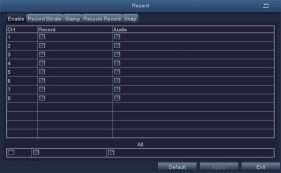
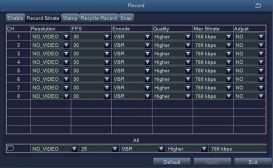
[Resolution] The recording resolution for each channel [FPS] Selection range: 1-30 (NTSC) 1-25 (PAL)
[Encode] The camera’s encoding type, support VBR and CBR
[Quality] The higher the quality, the clearer the video image. Options include Lowest,
Lower, Low, Medium, Higher, and Highest [Max Bitrate] Range: 256kbps ~ 2048kbps
[Adjust] The video format, including CVBS, AHD, CVI, and TVI
Note:These functions are not optional
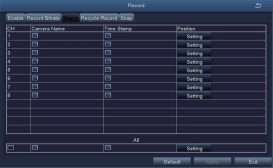
[Camera Name] Select whether to display the camera name or not [Time Stamp] Select whether to display time on this channel or not
[Position] Click this button and users can use the mouse to drag the camera name and timestamp to any position on the live screen.
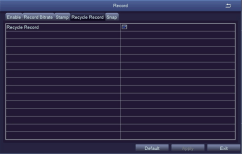 Recycle Record
Recycle Record
When selected, the DVR will automatically overwrite the oldest files and continue recording when the hard disk is full. If not selected, the DVR will stop recording when the hard disk is full and prompt “Insufficient remaining space” on the screen.
Recording schedule contains 6 submenus: Schedule, Motion, Sensor, PIR, Vehicle , and Human.
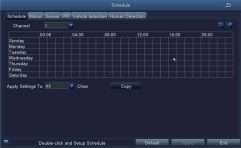
[Copy] Apply the recording schedule of a certain channel to other channels or all channels.
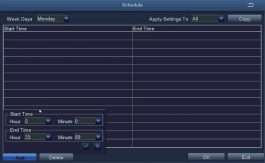 Select the channel, double-click the left mouse button, and edit the weekly plan.
Select the channel, double-click the left mouse button, and edit the weekly plan.
[Add] Add a recording schedule for a certain day [Delete] Delete the selected schedule
[Copy] Copy the schedule of a specified date to other dates. Double-click the left mouse button to customize the effective recording mode time for each day of the week.
The setting is the same as that of scheduled recording, please refer to scheduled recording setting.
NOTE: The default schedule for motion detection recording is all selected.
The setting is the same as that of scheduled recording, please refer to scheduled recording setting.
NOTE: The default schedule for sensor alarm recording is all selected.
The setting is the same as that of scheduled recording, please refer to scheduled recording setting.
NOTE: The default schedule for PIR detection alarm recording is all selected.
The setting is the same as that of scheduled recording, please refer to scheduled recording setting.
NOTE: The default schedule for vehicle detection recording is all selected.
The setting is the same as that of scheduled recording, please refer to scheduled recording setting.
NOTE: The default schedule for human detection recording is all selected.
The Alarm configuration contains 7 sub-menus: Sensor Alarm, Motion Detection, Video Loss, PIR Detection, Human Detection, Vehicle Detection, and Other Alarms.
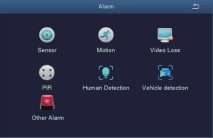
NOTE: Some products may cancel sensor alarm recording due to product differences.
1-1. Basic Configuration
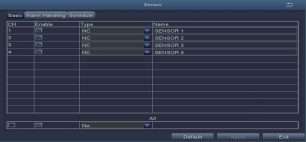
[Enable] Enable the sensor alarm function for the corresponding channel [Type] Select the alarm type: Normally open or Normally closed
[Name] Set the name of the sensor
1-2. Alarm Handling
[Holding Time] Select the alarm delay time, with options of 5s, 10s, 20s, 30s, 60s, 120s, Always
[Trigger] Click to set alarm configuration, trigger recording, PTZ linkage, etc. [Buzzer] When selected, the buzzer will sound when an alarm triggered
[Show Full Screen] When there is an alarm trigger, the alarm will pop up in full- screen display
[To Alarm Out] Select to trigger the alarm output on a specified channel
[Email] When an alarm is triggered, the system will send relevant information to the user’s designated email, such as the alarm event, snapshot, device name, device number, etc.
[Snap] When an alarm is triggered, the system will automatically capture and save images of the selected channel
[To Record] Select the channel to trigger recording
[To PTZ] To set the action type and serial number of the linkage
1-3. Schedule
The schedule settings for sensor alarm are the same as for scheduled recording. For specific setting steps, please refer to 4.2.4 [Recording Schedule] -[Schedule] NOTE: The default schedule for sensor alarm is Select All
Motion Detection contains 2 sub-menus: Motion and Schedule.
2-1. Motion Detection
By analyzing the video image, when the system detects motion signals that reach the preset sensitivity, it will trigger motion detection alarms and activate the linkage function to push the alarm information to the App or email.
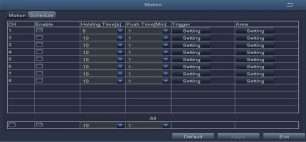
[Enable] After selected, the Motion detection function of the corresponding channel is turned on, and it is enabled by default
[Holding Time] Select the alarm delay time for the channel, which can be set to 5s, 10s, 20s, 30s, 60s, 120s, or Always on.
[Push Time] Set the time interval for pushing alarm notification to the mobile App, which can be set to 1min, 2min, 3min, 5min, 8min, or 10min.
[Trigger] The setting is the same as that of sensor alarm, please refer to 4.2.5 Alarm Configuration – Sensor
[Area] In this interface, users can drag the scroll bar to adjust the sensitivity value (1-8), the default value is 6, the smaller the value, the higher the sensitivity. Because the sensitivity is affected by factors such as color and time (day or night), users should adjust the value according to the actual situation.

Click or drag the mouse to select or erase the detection area.
![]() Click the star icon to set the entire field of view as a sensitive area
Click the star icon to set the entire field of view as a sensitive area
![]() Click the trash icon to clear the current detection area
Click the trash icon to clear the current detection area
![]() Click to save settings
Click to save settings
![]() Click to log out
Click to log out
The sensitivity index ranges from 1 to 8. The default sensitivity is 6. The lower the value, the more sensitive. The higher the value, the less sensitive.
Note: It is best not to have flags,trees or other objects that are easy to flutter in the wind in the grid for motion detection to avoid false alarms.
2-2. Schedule
The setting of the motion detection schedule is the same as that of the scheduled recording. Please refer to 4.2.4 [Recording Schedule]-[Schedule] for specific
setup steps. This function controls the effective time of the motion detection feature. Note: The default schedule for motion detection is to Select All.
This function needs to be used with a camera with PIR (Passive Infrared) capability. After PIR detection is set, the DVR will only record when it detects human life, and push the alarm notifications to the App or mailbox.
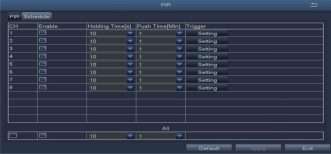
[Enable] After selected, the PIR detection function of the corresponding channel is turned on, and it is enabled by default
[Holding Time] Select the alarm delay time for the channel. Options: 5s, 10s, 20s, 30s, 60s, 120s, Always
[Push Time] Set the time interval for alarm notifications to be sent to the App.
Options: 1min, 2min, 3min, 5min, 8min, 10min
[Trigger] The setup method is the same as sensor alarm. Please refer to 4.2.5 Alarm Configuration – Sensor
[Schedule] PIR detection schedule setting is the same as Schedule Recording. For detailed instructions, please refer to 4.2.4 Recording Schedule. This feature controls the effective time of PIR detection
By analyzing the video image, the system activates human detection alarm when
it detects human figure. It also triggers linkage functions and sends alarm notifications to the App or mailbox.
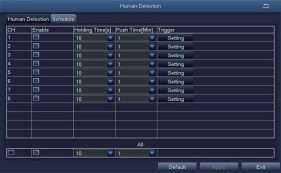
[Enable] After selected, the human detection function of the corresponding channel is turned on, and it is enabled by default
[Holding Time] Select the alarm delay time for the channel. Options: 5s, 10s, 20s, 30s, 60s, 120s, Always
[Push Time] Choose the time interval for alarm notifications sent to the App. O ptions: 1min, 2min, 3min, 5min, 8min, 10min
[Trigger] The setup process is the same as sensor alarm configuration, please refer to
[Schedule】The schedule settings for human detection alarm are the same as Schedule Recording. For detailed instructions, please refer to 4.2.4 Recording Schedule. This feature controls the effective time of human detection
By analyzing the video image, the system detects vehicle contours and triggers motion detection alarms. It also activates the linkage function to send alarm notifications to the App or mailbox.
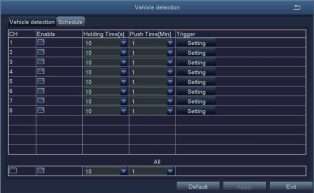
[Enable] After selected, the vehicle detection function of the corresponding channel is turned on, and it is enabled by default
[Holding Time] Select the alarm delay time for the channel. Options: 5s, 10s, 20s, 30s, 60s, 120s, and Always
[Push Time] Set the time interval for sending alarm notifications to the App. Options: 1min, 2min, 3min, 5min, 8min, and 10min
[Trigger] The setup process is the same as for sensor alarm configuration. Please refer to 4.2.5 Alarm Configuration – Sensor
[Schedule] The schedule settings for human detection alarm are the same as Schedule Recording. For detailed instructions, please refer to 4.2.4 Recording Schedule. This function controls the effective time of vehicle detection
The handling of video loss alarms is the same as for sensor alarms. For detailed instructions, please refer to 4.2.5 Alarm Configuration – Sensor
[Alarm Types] Including Disk Full, IP Conflict, Disconnect, Disk Shortage Alarm,
Disk lost
[Buzzer] When an alarm occurs, the device emits two long beeps.
[Email] When an alarm is triggered, the system sends relevant information such as the alarm event, snapshots, device name, and device ID to the user’s specified email address.
[To Alarm Out] After selected, and an alarm will be triggered on the specified alarm output.
[Disk Shortage Alarm] When the remaining capacity of the hard disk reaches the set value, an alarm will be triggered.
Network Configuration contains 4 sub-menus: Network, Email, WIFI Setup, DDNS
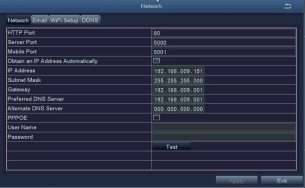
[HTTP Port] 80 by default [Server Port] 5000 by default
[Mobile Port] 5001 by default [Obtain an IP Address Automatically] Enable automatic IP address acquisition
[IP Address] Set the IP address of the device [Subnet Mask] Set the subnet mask of the device
[Gateway] Set the default gateway of the device
[Preferred DNS Server] This address is provided by your internet service provider (ISP). It must be filled in when using mobile monitoring.
[Alternate DNS Server] This address is provided by your internet service provider (ISP).
[PPPOE] Enable this option to establish a network connection using PPPoE. The connected IP address can be checked in[Main Menu]- [Information]- [Network] [User Name] Enter ISP (provided by Internet Service Provider)
[Password] The password set
[Test] Test whether the input IP address or PPPoE information is valid
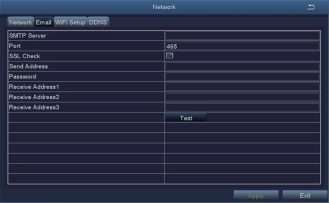
[SMTP Server] Mail server address, which can be an IP address or a domain name
(if it is a domain name, ensure that DNS is correctly configured for proper resolution).
For example: smtp.gmail.com
[Port] Mail server port number, the default port is 465
[SSL Check] Enable SSL (Secure Socket Layer) protocol for secure login [Send Address] The email address of the mail server
[Password] The password for the sender’s email address
[Receive Address] When an alarm occurs, it will be sent to the set email address. Up to 3 recipient email addresses can be set
[Test] Test the current email configuration to check if it is successful.
This function can only be used with an external WiFi module
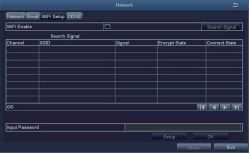
[WiFi Enable ] Enable WiFi connection after selected
[Search Signal] Search for nearby WiFi signals after enabling WiFi
[Input Password] Select the searched WiFi network and enter the corresponding password
[Configure] Set dynamic IP or static IP
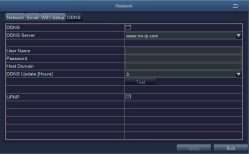
[DDNS Server] Website of the domain name resolution service provider.
Options: www.meibu.com, www.no-ip.com
[User Name] The account used when registering the domain name [Password] The password corresponding to the registered account [Host Domain] The domain name of the domain name resolution server.
Save the settings and exit, you can directly access the device using Internet Explorer (IE)
Manage the user permissions for this device. The default user “admin” is the super administrator and there is no password by default.
NOTE: The maximum length for usernames and passwords is 32 bytes.
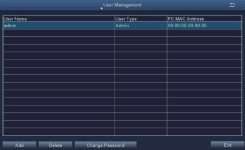
[Add] : Add a username and set the user’s permissions. Clicking on it will bring up the following interface:
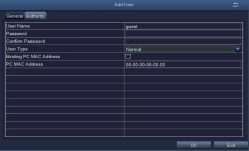
NOTE: Some products may cancel the RS485 interface due to product differences.
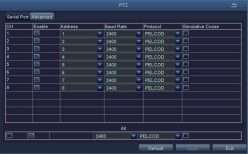
[Address] The address of the PTZ device
[Baud Rate] The baud rate of the PTZ device. Options: 110, 300, 600, 1200, 2400,
4800, 9600, 19200, 34800, 57600, 115200, 230400, 460800, 921600
[Protocol] The communication protocol of the PTZ device. Options: PELCOP, PELCOD, LILIN, MINKING, NEON, STAR, VIDO, DSCP, VISCA, SAMSUNG, RM110, HY,
N-control [Simulative Cruise] When selected, after adding preset points in the
cruise line configuration, preset point cruising can be achieved regardless of whether the PTZ device supports the cruise line function.
[Preset] Click the [Setting] to open the following window:
Users can adjust the PTZ to the desired position through the button on the tool bar. Click [Save] and the preset point is set. Up to 128 preset points can be set.
[Cruise] Click the [Setting] to open the following window:
[Add] Add a cruise line (up to 8 cruise lines can be added)
[Setup] After selecting a cruise line, click Setup to open the add preset point interface, as shown below:
|
|
Add preset point |
|
Delete the preset point |
|
Modify the selected preset point |
[Track]
[Start Record] Control the PTZ to move up, up-left, down, down-right, left, down-left, right, up-right, or stop recording the PTZ’s movement trajectory.
[Start Track] To execute the recorded trajectory.
NOTE: Each channel can only record one track, which is automatically saved after recording. When calling a track, simply select the channel to start track.
Advanced Setup contains 3 sub-menus: Reset, Import/Export, System Maintenance
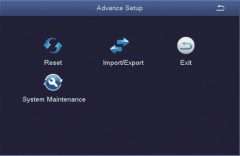
[Reset] Restore all settings to factory settings
[Import/Export] Export device parameters to a portable storage device or import data from a portable storage device to the device
[System Maintenance] The video recorder defaults to restart automatically every week at 2:00 am on Monday. User can choose to restart Daily, Weekly, Never.
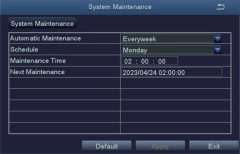
Data search contains Time Search, Event Search, Image
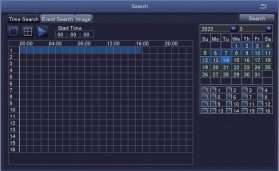
Select a channel and start playing
[Search] Search the video files for the selected channel and time. Click the Play icon to start playback.
NOTE: Dates in the calendar marked with blue squares indicate recorded footage.
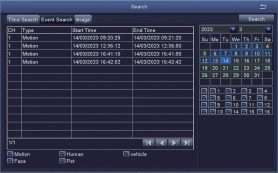
[Search] Search the video files for the selected channel and time. Choose the desired time, click Search and select the file, and double-click the mouse to start playback.
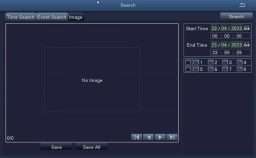
[Search] Search for images for the selected channel and time.
[Save] Save the currently displayed image to a portable storage device. [Save All] Save all captured images to a portable storage device.
NOTE:
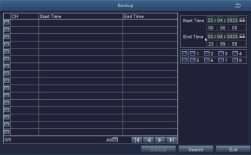
By configuring the settings, the video files in the device can be backed up to the external storage device.
NOTE: Before backing up files, make sure to install a storage device that can accommodate the backup files.
[Search] Select the files to be backed up based on the time and channel.
[Backup] Select the files from the list, click Backup, and a backup information interface will pop up, as shown in the figure:
[Disk Cleanup] Delete all files in the external storage device.
Information contains 5 sub-menus: System, Event, Log, Network, Online Users
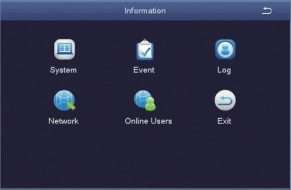
Display the basic information of the device, including hardware information, software version, Launch Date, and Device ID. Users can scan the QR code to download the mobile App and obtain the mobile port number of the device.
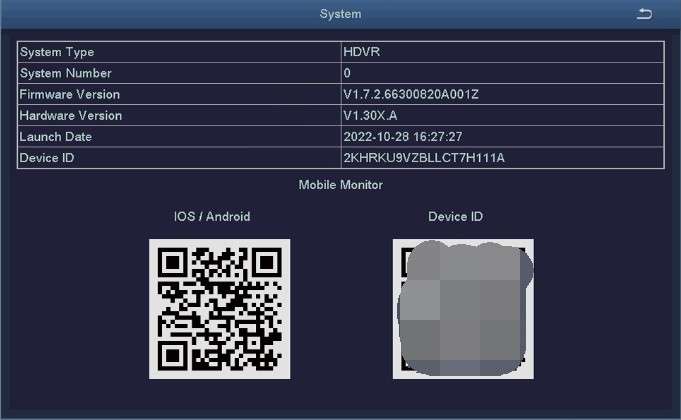
Users can select the event information to query, such as motion detection alarm, human detection alarm, vehicle detection alarm, video loss alarm, PIR detection alarm, etc., based on time, channel, and other criteria.
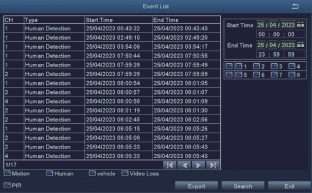
Search the operation information of the logged-in user according to time, operation type, etc. Please note that formatting the hard drive will clear the log information.
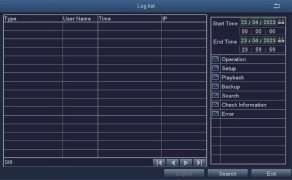
Check the relevant parameters of the network settings.
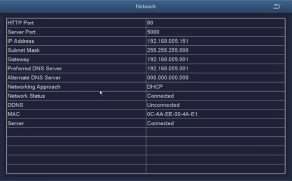
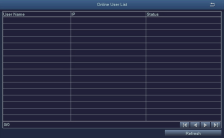 Check the network user information connected to the local DVR.
Check the network user information connected to the local DVR.
[Refresh] Re-detect recognizable hard drives.
[Browse] View information of the selected hard drive, including capacity, remaining space, disk status, attributes, total number of pictures that can be stored, and number of pictures that have been saved.
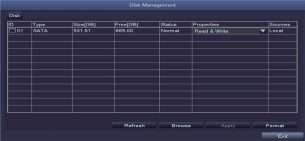 [Format]: Delete data in the selected hard drive, including locked files and pictures.
[Format]: Delete data in the selected hard drive, including locked files and pictures.
The current user logs out of the system. If the user wants to log in again, they can click on the main menu icon and enter their username and password on the login interface to log back into the device.
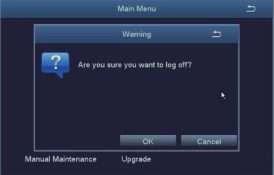
Click it to initiate a system reboot for maintenance purposes.
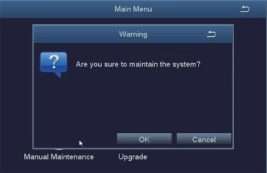
5 FAQs
Q: Does the system support motion detection and image capture?
A: It captures images automatically when people, cars, are detected or when there is a change in detected images. Users can also manually capture images using our ZOSI Smart APP.
Q: Why can’t my device connect to the Internet?
A: Please check
Q: Why can’t I search for video files?
A: Please check
Q: Why can’t some channels be displayed?
A: Please check
